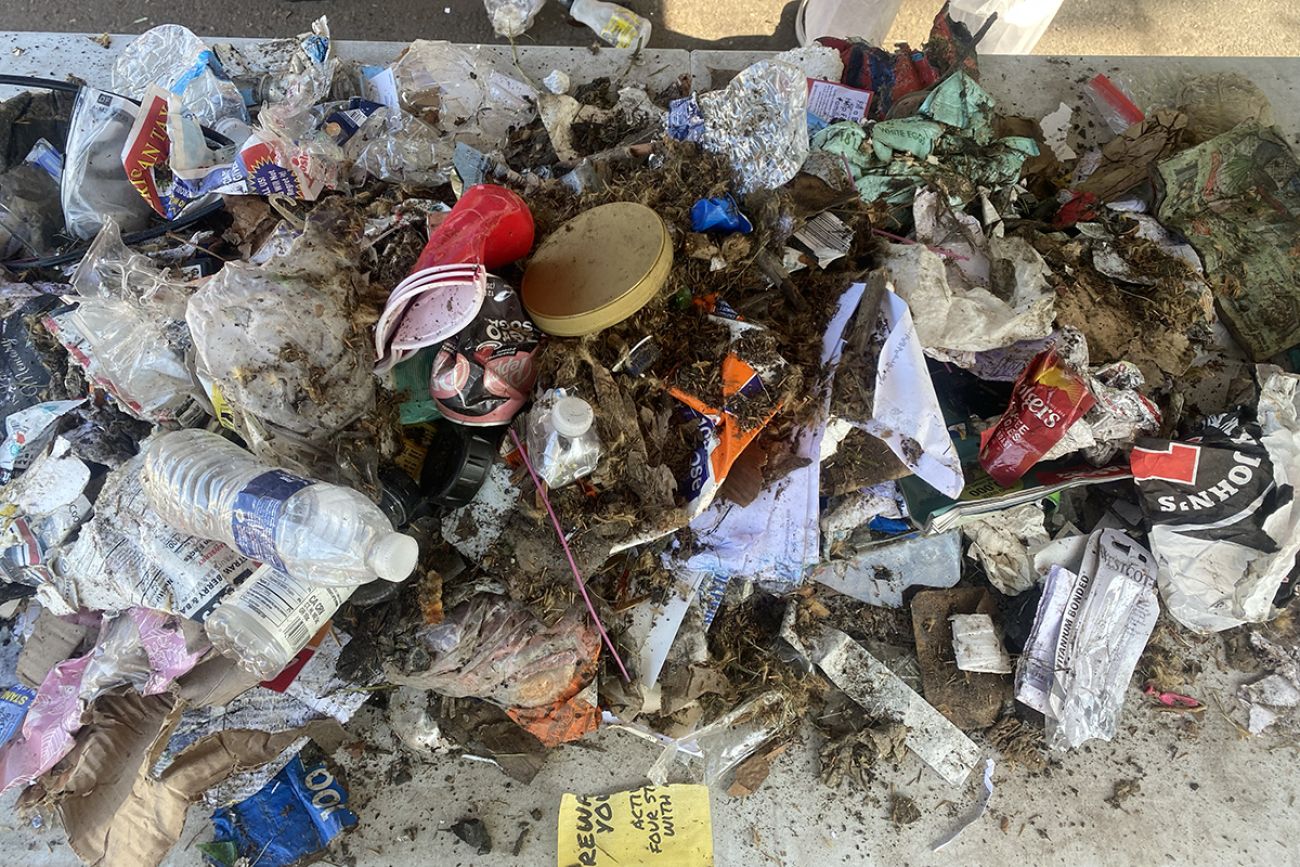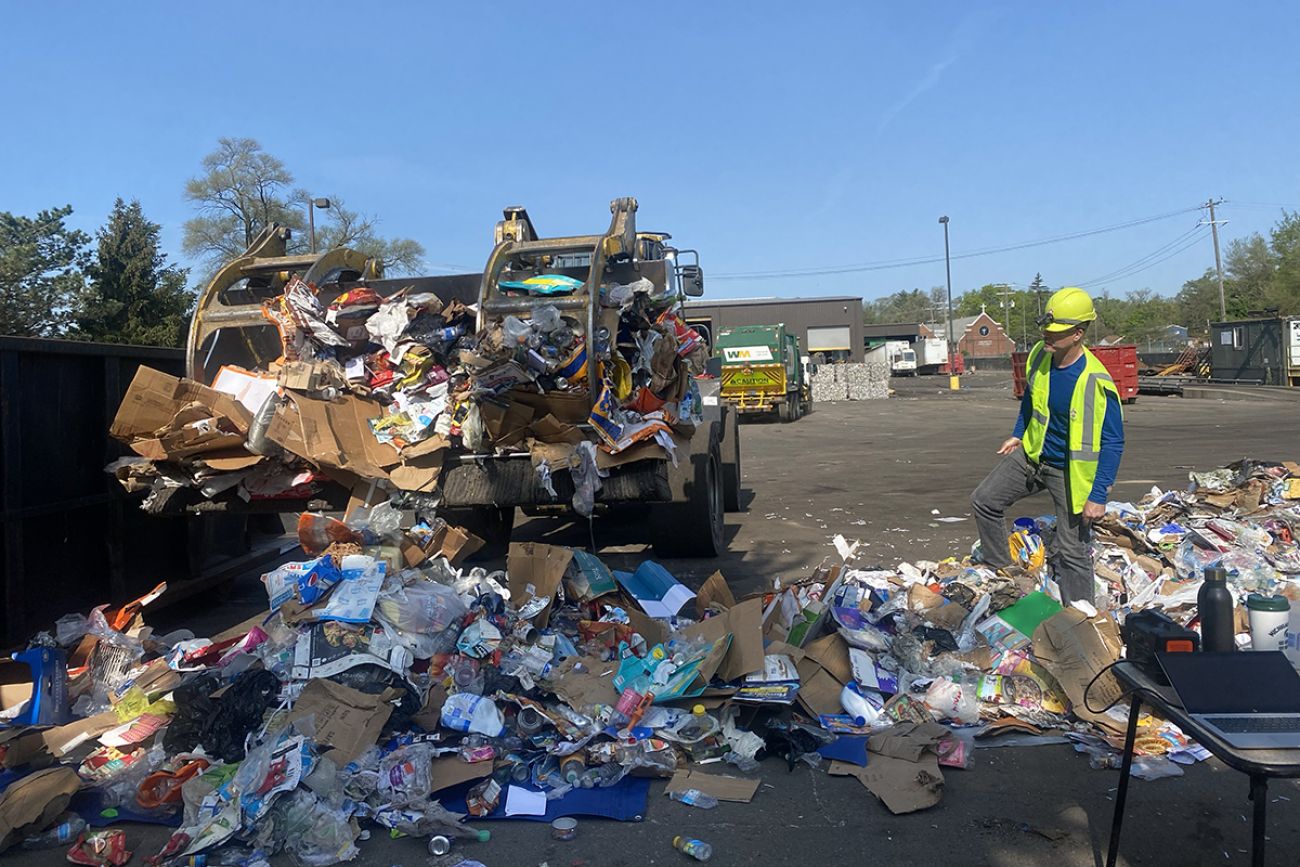Detroit recycling rates double, but barriers remain

Hundreds of pounds of supposedly recyclable items from municipal recycling bins in Detroit were laid out on tarps across the parking lot of Materials Recovery Facility on Eight Mile.
For two days, volunteers, environmental advocates, and city employees worked to sift, sort, and weigh more than 2,000 pounds of the materials, shovel by shovel.
The group, led by waste education nonprofit Green Living Science, was conducting an audit to see what’s being recycled and how much. The team also was assessing how often items go into recycling bins that aren’t actually recyclable, or the contamination rate. Yard waste, pudding cups, Barbie dolls, and a pair of brand new shoes were among the garbage that BridgeDetroit observed in what should have been recycling piles.
Related:
- Reducing food waste in Michigan? There’s an app for that
- Allergies may be getting worse in Michigan. It’s not just you
- Once beset by industrial pollution, Rouge River on a slow path to recovery
When items like those as well as food, plastic bags, and used tissues are put into residential recycling bins it contaminates the other materials and, at a certain rate, the entire load will instead go to a landfill.
With increased information from the audit, advocates are hoping to better inform the city’s efforts to curb contamination and increase recycling rates overall. Additionally, the city plans to pilot an opt-out recycling program and build support for decentralized community-based composting to decrease the amount of waste sent to landfills. Landfills are the third-largest source of human-caused methane, a greenhouse gas that contributes to climate change and global warming, according to the U.S. Environmental Protection Agency.
Detroit, the last major U.S. city to implement citywide curbside recycling, has historically had a very low recycling rate. Until recently, Detroit’s recycling rate – or how much of total waste generated is recycled – peaked at 4%, compared to the state average of 19%.

The amount of Detroiters recycling and diverting waste from landfills is on the rise though, according to Madison Kraus, recycling coordinator for the City of Detroit.
“Last year we reported at about 8%. Our goal is to hit 15% in two years,” she said. The state’s recycling average has also risen, and is now 21%.
Kraus said the city hopes that by 2030, 30% of materials that would have otherwise been sent to the landfill, will be composted or recycled.
“We have a lot of uncaptured recyclables – there’s a lot of potential to recycle more,” Kraus said.
Just 40% of Detroit residents – or around 80,000 households – participate in curbside recycling, Kraus said. But approximately 84% of Michigan waste sent to landfills is recyclable or compostable, according to a 2021 NextCycle Michigan analysis. The majority of that waste comes from Southeast Michigan, the NextCycle report notes.
“This is all about really dealing with this bigger existential issue – recycling is not easy, it’s inconvenient, it’s complicated,” said Mike Shesterkin, who came from Livonia to volunteer for the audit. Shesterkin is also co-chair of the state and local policy subcommittee of the Detroit City Council’s Green Task Force.
“That’s what motivates my being here, to do something about that,” he said.
Piloting opt-out recycling
Currently, Detroit residents have to opt-in to curbside recycling by participating in a short educational training for a free bin, or paying $25 to obtain one.
When the city first began recycling in 2015, it gave out 30,000 containers, but those containers were used by some residents as secondary trash receptacles and the contamination rate was high, according to city officials. So the city created an opt-in program, to ensure that the people using the bins were really interested in recycling. But the program became a partial barrier to recycling.
“A lot of it is just making sure we have an accessible program,” Kraus said. “We have an opt-in program right now so there’s a lot of barriers to even having a recycling bin and then on top of that knowing what goes in it and what type of material you can recycle.”
To that end, the city is working to finalize a grant with the Department of Environment, Great Lakes, and Energy (EGLE) to pilot an opt-out recycling program–residents would automatically receive a recycling bin and have to opt-out if they don’t want to participate. The program will be piloted in “a small area” Kraus said, but the details on where and value of the grant have not been finalized.
Getting people the bins is just the first step, the other major hurdle is contamination. Nearly a quarter of the items going into Detroit recycling bins aren’t recyclable, according to Green Living Science, an education contractor for the city.
One of the most common contaminants the audit uncovered was yard waste.
“If a family runs out of a brown paper (yard waste) bag sometimes they just put it in the recycling,” or trash, said Natalie Jakub, executive director of Green Living Science, adding that a lot of Detroit residents don’t realize they can use a 30 gallon garbage container from the store for yard waste, and that it will get picked up.
To learn more about what can be recycled, Green Living Science has a number of resources online, in addition to information on the city’s website.
The last time Green Living Science did a Detroit recycling audit was in 2019. The organization received a grant with the city for training to conduct the audit and get supplies. They planned to do it every year before COVID-19 happened and put a pause on the plan.

The group analyzes a small sample of recyclable materials from Detroit that get sent to Materials Recovery Facility. The recycling building can process up to 20 tons per hour from curbside recycling programs, commercial and industrial businesses, and items dropped off.
Multi-family buildings like apartment complexes and condominiums, and commercial buildings are complicated in their own right.
It wasn’t until 2020 that Detroit began offering recycling to multi-family units through a grant from EGLE that allowed the city to purchase recycling trucks and containers. An 18 gallon interior bin is free, a 96 gallon recycling bin is $450 per year, and a 450 gallon recycling dumpster is $900 per year. Residential condominiums, however, are not eligible for the service.
Approximately 63% of Michigan’s trash comes from the commercial and institutional sectors, according to the NextCycle report.
Kraus said the city doesn’t have information on the number of multi-family buildings that recycle. Many contract with private waste management companies.
“The city is working to increase our outreach to multifamily property owners in partnership with Green Living Science,” Kraus said.
Previously, Jakub, co-chair of the recycling and waste reduction committee, was working on an ordinance to make it mandatory for commercial buildings to recycle, but now she said they are working with the city on a “universal recycling ordinance.”
There are several challenges with commercial recycling in Michigan, she said, including waste-haulers that do not accept single stream recycling, downtown buildings designed for only one waste stream and a mismatch between the sideloading design of city waste trucks and certain facilities.
Composting
Last year, residents and community members piloted a community-led composting initiative in a few Detroit neighborhoods.
When the compost pilot was completed last year, the leaders presented the findings to Detroit to inform what a citywide composting program could look like.
According to the report from the Global Alliance for Incinerator Alternatives (GAIA), which helped lead the pilot, with better waste management policies Detroit could reduce its harmful greenhouse gas emissions by 102%, or equal to a year of energy use for approximately 50,000 homes.
“Everyone wants to see curbside composting happen, we just don’t have the facility necessary to be able to do a really broad composting campaign from the municipal level,” said Kraus at the city. “It’s not always so cut and dry as ‘oh, we’ll put food waste in our yard waste.’”
Food waste is the most common item found in landfills, according to the U.S. Environmental Protection Agency, comprising 24% of landfill materials and 22% of combusted municipal solid waste.
“So what we’re trying to focus on is engaging with the smaller community farms and urban gardens that are already composting and provide some drop off sites,” said Kraus, adding the city has applied for several grants in the last few years to try and support that work.
“Highest and best use for food scraps is to keep it as local as possible,” added Kraus, explaining that if the city collected compost and shipped it off to a nearby suburb it wouldn’t be ideal, for example.
In 2021, a little more than 2,000 metric tons of material was diverted by grassroots-led composting initiatives, according to the GAIA report.
“We’re trying to really build up the decentralized composting scene,” said Kraus. The city, she said, doesn’t want to “hinder the growth of the decentralized and backyard composting movement” in Detroit.
Michigan Environment Watch
Michigan Environment Watch examines how public policy, industry, and other factors interact with the state’s trove of natural resources.
- See full coverage
- Subscribe
- Share tips and questions with Bridge environment reporter Kelly House
Michigan Environment Watch is made possible by generous financial support from:
Our generous Environment Watch underwriters encourage Bridge Michigan readers to also support civic journalism by becoming Bridge members. Please consider joining today.
See what new members are saying about why they donated to Bridge Michigan:
- “In order for this information to be accurate and unbiased it must be underwritten by its readers, not by special interests.” - Larry S.
- “Not many other media sources report on the topics Bridge does.” - Susan B.
- “Your journalism is outstanding and rare these days.” - Mark S.
If you want to ensure the future of nonpartisan, nonprofit Michigan journalism, please become a member today. You, too, will be asked why you donated and maybe we'll feature your quote next time!






